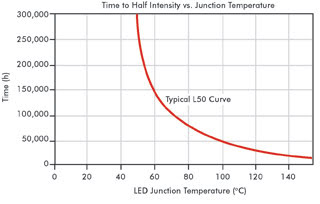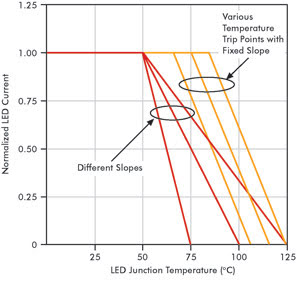Rick Zarr, National Semiconductor Corp.
The US Department of Energy’s Energy Information Administration (EIA) reported in 2007 that the US had used roughly 526 billion kilowatt-hours of electricity for lighting (both commercial and residential). In 2008, the EIA reported that a typical American nuclear power plant produced roughly 12.4 billion kilowatt-hours.
Simple math shows that the lighting needs of the US alone require roughly the equivalent of more than 42 nuclear power plants. As the global population has continued to grow, the lighting industry has pursued new light sources with higher efficiencies to reduce the energy consumed.
LEDs have long been the panacea of the lighting world, promising replacements for various incandescent, fluorescent and gas discharge sources that reduce energy consumption and keep harmful chemicals out of landfills. However, it has long been known that, even though the efficacy of LEDs approaches or exceeds that of high-efficiency sources such as high-intensity discharge lighting, the implementation, drive electronics and overall brightness fall short.
LEDs have suffered from the way light is produced independent of the material from which they are fabricated. The light produced inside an LED is often in a mode that is not radiative and has a high probability of being reabsorbed, resulting in waste heat. Heat produced by the Stokes shift in phosphor-based white LEDs creates additional efficiency losses. Several innovative methods can improve both the radiative recombination rate and the extraction of photons to increase the brightness and efficiency of LEDs.
A leap in brightness
One method, pioneered by Luminus Devices Inc., is an implementation of a photonic lattice to provide waveguides for photons trapped in the substrate. Photonic crystals also occur naturally in nature and can be seen in materials such as opal. The ability of closely spaced structures to provide paths for emission greatly improves the intensity of the light produced. With this and other improvements, such as the use of quantum wells and optical cavities, LED brightness has blown through the roof. These devices are finding their way into all kinds of high-brightness applications, such as video projectors, LCD backlights and others, but the future application is for general lighting.
In any lighting application, there are issues with the life span of the source. It either dies a sudden death, as with a filament failure in an incandescent bulb, or it slowly degrades with time due to the aging of the material. LEDs also suffer from aging, which is directly affected by the junction temperature of the device. If a fixture is engineered to provide a certain luminance, over time this luminance will degrade below some useful limit. The life span will typically end at some number relevant to the application. For instance, a streetlamp application may be useful well down to 50 percent of the original luminance, but a medical endoscope light source may not.
Managing loss of luminance
The end-of-life point where the luminance falls below a useful level is highly temperature-dependent (see Figure 1). Say the curve in Figure 1 represents a light source for designing a practical, general-purpose lighting solution. If the source must last at least 50,000 hours before its light output is only 50 percent, the junction temperature must never exceed 100 °C. This is very difficult without active cooling. Compounding the problem is the lack of radiative emission of waste heat. Incandescent bulbs will radiate a large amount of heat in the infrared, but LEDs need to conduct heat away. Additionally, if the junction temperature even momentarily exceeds the maximum allowed temperature provided by the manufacturer, permanent damage will occur, dramatically affecting the life span of the emitter.

Figure 1. Temperature Effect on LED Luminance.
If the LED cannot be modified to handle extreme junction temperatures without degrading, two factors must be considered when designing the lighting system or engine: thermal management and LED driver awareness. Both of these apply not only to general lighting applications but also to specialty uses. The easiest solution is passive thermal management using a heat sink along with enough air flow to remove the waste heat. A company called Nuventix Inc. has developed an active cooling solution with no rotating components that is based on entrainment caused by high-speed air jets. The way it works is similar to how a cyclist is swept up and pulled along in the wake of a tractor-trailer; ambient air in the Nuventix cooler is pulled along in a similar fashion, providing highly efficient cooling. This technology has been applied to industry standard lighting configurations such as MR16, PAR20 and PAR25.
The other part of the solution is active thermal management via the LED driver. Traditionally, LED drivers have been simple constant current sources that monitor and control only the current flowing into one or more LEDs. In general, this is sufficient to drive the LED and maintain brightness over varying input voltage levels. However, with advances in brightness and changes in configuration to provide even brighter sources, LEDs have evolved into light engines complete with thermal control demands.
To prevent damage and premature end of life, thermal control is required and can be implemented in various ways. Figure 2 shows two different fold-back curves that limit the LED current as the temperature increases. As long as the junction temperature remains below a preset point, normal current regulation is the primary control loop. However, once the set point is exceeded, a secondary control loop engages to limit the current. The temperature at which the fold-back occurs and the rate at which the drive current is reduced will both vary depending upon the application or the LED manufacturer’s recommendations.

Figure 2. Examples of Thermal Fold-back Curves.
State-of-the-art LED drivers, such as the National Semiconductor LM3424, have the thermal fold-back feature built in, allowing the designer to select the set point and gain (which selects the slope) of the system. This greatly simplifies high-power LED supplies for general lighting or specialty applications, such as emergency signage, where LED failures caused by aging or high temperatures can be catastrophic.
Making the switch
With new technology come new issues, and LEDs are no exception. As the efficacy and overall intensity of LEDs continue to increase, more lighting applications will move away from conventional sources and adopt these new lighting systems. New cooling and driver technologies are making thermal management much easier to implement and, in terms of life span, LEDs provide the potential for never requiring replacement – something an incandescent bulb would be hard-pressed to achieve.
Meet the author
Rick Zarr is a technologist for PowerWise Products at National Semiconductor in Florida, and he writes an energy-efficiency blog at www.national.com/energyzarr; e-mail: [email protected].